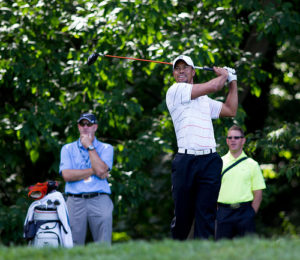Continuation of Rules of Etiquette
- Depending on the hole’s par, where you want your tee shot to go will vary. If you are playing a par 3 hole, your goal will be to land your ball on, or very near, the putting green. If you are playing a par 5, your goal will be to get your ball to land as far up the fairway toward the putting green as possible.
- After each player has hit their tee shot, the game is advanced to the ball farthest from the hole—or you could say the ball closest to the teeing ground. This routine continues until the final ball is in the hole.
- Once every player has their ball on the putting green, or is close enough to the putting green to see the cup, the flagstick can be removed from the hole. If one player is farther out, the flagstick can be replaced for his shot until he is closer to the hole.
- It’s acceptable for a player to request that another player hold the flagstick in the hole while they line up their putting shot. However, the flag must be removed as soon as the ball is struck.
- If a ball is putted and lands in a cup and it still has the flagstick in it, the player can be penalized two strokes.
- Replace the flagstick before you continue to the next hole.
- While a round of golf generally takes about 4 hours for walkers and less time for those riding carts, groups that have beginning golfers in them may take more time. If your group is holding up another group and they are continually waiting on your group, you should extend them the courtesy to “play through” – this means that you let them go ahead of you. This is golf etiquette and it’s rude to keep another group of players who have a quicker playing pace waiting.
- If you are in a group of 4 and a group of 2 is behind you, wave them on through as they will be slowed down by your larger group.
- Players are not allowed to touch or move their balls from their resting positions. Violating this rule will result in a one stroke penalty.
- If a ball moves on its own or because of outside interference that is not player related, there is no penalty.
- If another player accidentally moves another player’s ball, it can be replaced to its original spot without a penalty.
- If playing on a team, no players are allowed to move or touch their teammate’s ball. If they do, a one stroke penalty will be handed out.
- Players are not allowed to do anything to the area around their ball—such as flattening grass or lifting buried balls out of the sand—and they are not allowed to let anyone do this for them.
- Any player who pretends to make a practice swing in an attempt to rearrange the area surrounding the ball will be penalized.
- If a player’s ball becomes damaged to the point that it’s no longer fit for play, the ball can be replaced with another in the sight of opponents. This can only be done on the hole where the damage occurred and the replacement ball must be placed where the damaged ball was located.
- If players lose their balls, or they go out of bounds and are not retrievable, players can take a one stroke penalty and play a new ball from the original spot that resulted in the ball being lost or going out of bounds. However, in addition to the one shot penalty, they must also count the original shot that resulted in the lost, or out of bounds, ball.
- If a player’s shot should tear up the grass, known as a divot, it should be repaired as best you can.
- Shots made from sandy bunker areas should be restored back to normal after a shot is complete.
- Never take too much time on the putting green after the hole is complete. After you’ve finished up, move along. You can mark your card after you are off the putting green.
These are just a few of the rules of etiquette that you should know and they can serve as a great foundation for beginning golfers. As more time passes and you play more often you’ll be in situations where you can learn more.

